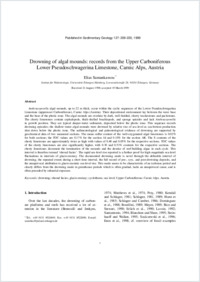Drowning of algal mounds : records from the Upper Carboniferous Lower Pseudoschwagerina Limestone, Carnic Alps, Austria
- Samankassou, Elias Department of Geosciences, University of Fribourg, Switzerland
-
07.09.1999
Published in:
- Sedimentary Geology. - 1999, vol. 127, no. 3, p. 209-220
English
Anthracoporella algal mounds, up to 22 m thick, occur within the cyclic sequences of the Lower Pseudoschwagerina Limestone (uppermost Carboniferous), Carnic Alps (Austria). Their depositional environment lay between the wave base and the base of the photic zone. The algal mounds are overlain by dark, well-bedded, cherty wackestones and packstones. The cherty limestones contain cephalopods, thick- shelled brachiopods, and sponge spicules and lack Anthracoporella in growth position. They are typical deeper-water sediments, deposited below the photic zone. This sequence records drowning episodes; the shallow-water algal mounds were drowned by relative rise of sea level as sea-bottom production shut down below the photic zone. The sedimentological and paleontological evidence of drowning are supported by geochemical data of two measured sections. The mean sulfur content of the well- oxygenated algal limestones is 0.02% for both sections; the TOC values are 0.17% for the section AI and 0.10% for the section AR. The S contents of the cherty limestones are approximately twice as high with values of 0.48 and 0.05% for the respective sections. TOC values of the cherty limestones are also significantly higher, with 0.30 and 0.51% contents for the respective sections. The cherty limestones document the termination of the mounds and the demise of reef-building algae in each cycle. This interval is therefore termed ‘shroud facies'. The rapid sea-level rise reported is a further proof for high-magnitude sea-level fluctuations in intervals of glacio-eustasy. The documented drowning mode is novel through the definable interval of drowning, the repeated events during a short time interval, the full record of pre-, syn-, and post- drowning deposits, and the unequivocal attribution to glacio-eustatic sea-level rise. This mode seems to be characteristic of an icehouse period and clearly differs from the drowning mode in greenhouse periods which is often gradual, lacks an unequivocal cause, and is often preceded by subaerial exposure.
- Faculty
- Faculté des sciences et de médecine
- Department
- Département de Géosciences
- Language
-
- English
- Classification
- Geology
- License
- License undefined
- Identifiers
-
- RERO DOC 4947
- DOI 10.1016/S0037-0738(99)00052-4
- Persistent URL
- https://folia.unifr.ch/unifr/documents/299567
Statistics
Document views: 118
File downloads:
- 1_samankassou_dam.pdf: 240
